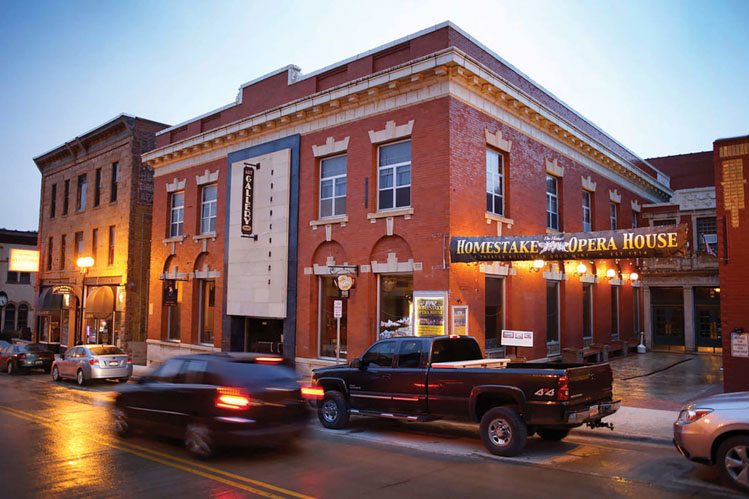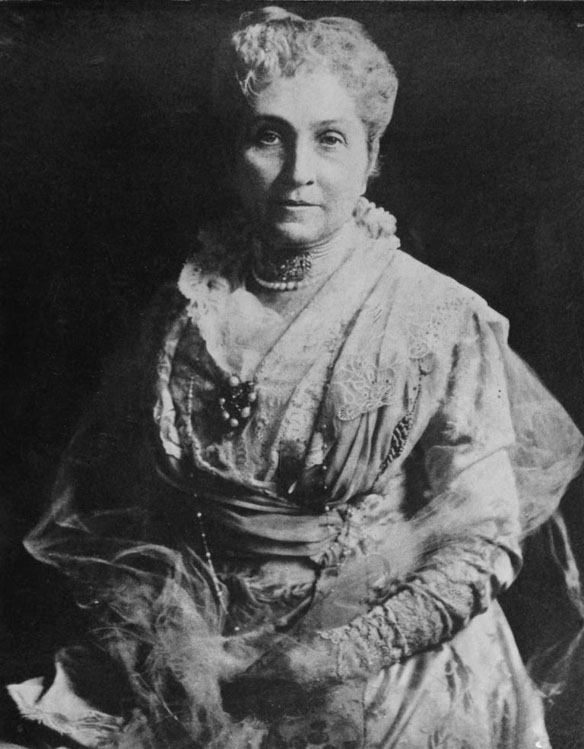The Gift of South Dakota
Subscriptions to South Dakota Magazine make great gifts!
Subscribe today — 1 year (6 issues) is just $29!
A Legacy in Lead
 |
| Phoebe Apperson Hearst's many philanthropic endeavors in Lead included the Homestake Opera House, which opened in 1914. |
Phoebe Apperson Hearst died in 1918, several decades before Linda Wiley was born, but their paths crossed in the small Black Hills community of Lead.
Linda studied Phoebe’s writings and accounts of her business and philanthropic ventures and brought her to life through a production on Lead’s Historic Homestake Opera House. Linda believes South Dakotans should know about this remarkable woman who made a big impact in the Black Hills. When Phoebe’s husband George Hearst (mining entrepreneur, U.S. senator from California and fictionalized villain in the HBO TV series Deadwood) died, his 48-year-old widow inherited every penny of his considerable wealth. She gave much of it away.
Her belief in helping those in need could be traced to when she and George lived in San Francisco in 1873, the year an economic depression gripped the country. The couple got by okay, “because of the mines. People in San Francisco fared worse and when I witnessed the impact on the city and families, my philosophy changed towards wanting to help the needy, for I realized I could help,” Phoebe said.
Okay, let me clarify. Phoebe said that in Linda’s script and through Minneapolis actress Kathleen Dodsen Smith’s interpretation. And Jon Steven Wiley, Linda’s actor husband, had a hand in things, too, as script editor. Dramatizing history is a complex matter but a great way to communicate true stories to a mass audience, if the writer, performer and script editor are skilled and conscientious. I can personally vouch for these three. Linda combines a love of the Black Hills with a professional ethic that insists on accuracy. I’ll explain before the end of this column but right now I don’t want to drift too far from Phoebe.
 |
| Phoebe Apperson Hearst. |
Phoebe considered George’s mining ventures across the West to be immune to the boom-and-bust phenomenon. Homestake grew continually, and after George’s death, Phoebe went to Lead and took a look. She invested in a private railway car she called the Lucania and traveled in comfort. Liking and apparently feeling somewhat maternalistic towards Lead’s people, she began sending $200 (nearly $6,000 in today’s dollars) to all 12 Lead churches every Christmas. She also endowed a fine library and was an advocate for what we now call early childhood education; Phoebe established a free kindergarten in the community. Some critics have looked at her love of Lead and her humanitarian gestures overall and wondered if she couldn’t have done more to prevent community hardship that stemmed from Homestake’s labor lockout over the winter of 1909-10. Whatever the case, Lead didn’t seem to direct anger toward her. Homestake’s board of directors in San Francisco took most of those barbs. Phoebe, meanwhile, rode the Lucania across the United States supporting a wide range of interests, from restoration of George Washington’s Mount Vernon home in Virginia to development of the University of California at Berkeley. She was the first woman to serve as a University of California regent. “I attributed my success in a man’s world of that time to politeness, clear goals, and sheer determination,” Phoebe says in Linda’s script. That style, Linda thinks, likely stunted Phoebe’s effectiveness as a suffragette, although that’s certainly where her sentiments were.
Her last gift to Lead, working with mine superintendent T.J. Grier, was the Homestake recreation building and opera house. In the script Phoebe expresses satisfaction with how Lead responded to an opening night opera in 1914: “I heard that there was standing room only with employees from the mine and their children!”
Historians have mostly overlooked Phoebe’s relationship with South Dakotans. Even Alexandria Nickliss’s fine biography, Phoebe Apperson Hearst: A Life of Power and Politics, only briefly touches on Lead in 664 pages. Thankfully, another California writer, Leta Miller, has written about Phoebe for the South Dakota State Historical Society, and the Homestake Adams Research and Cultural Center has archived South Dakota press accounts about Phoebe’s connections here.
All were resources for Linda, a native South Dakotan and meticulous researcher. She worked as a manager for Caterpillar, Inc., for 30 years across the United States and around the world. All the while, she and Jon knew they would retire to the Black Hills. They found their spot 7 miles outside Lead, and like Phoebe, quickly developed affection for the town. Both volunteered at the opera house that Phoebe made possible, and Linda served for a time on its board and then as president.
And she became a Phoebe Hearst expert. That’s very much a necessity in a town where residents told me the opera house — Phoebe’s final grand gift — is the very heart of the community.
Editor’s Note: This story is revised from the May/June 2022 issue of South Dakota Magazine. To order a copy or to subscribe, call (800) 456-5117.










Comments